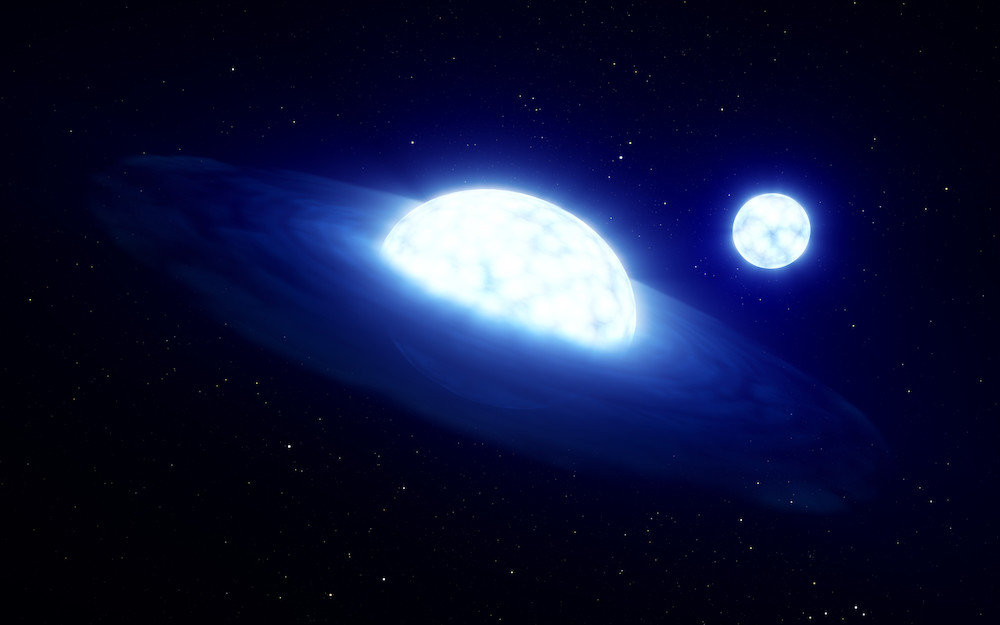Recent evidence shows the HR 6819 system is a vampire system and does not exist black hole in this system.
That’s science. Observations must always be confirmed before making a discovery. However, new evidence may actually undermine previous findings. And this is what happened.
” data-image-caption=”
Illustration of the HR 6819 double star system. Credit: ESO/L. Calçada
” data-medium-file=”https://i0.wp.com/langitselatan.com/wp-content/uploads/2022/03/Sistem-HR6819.jpeg?fit=300%2C188&ssl=1″ data-large-file=”https://i0.wp.com/langitselatan.com/wp-content/uploads/2022/03/Sistem-HR6819.jpeg?fit=1000%2C625&ssl=1″ width=”1000″ height=”625″ alt=”Ilustrasi sistem bintang ganda HR 6819. Kredit: ESO/L. Calçada” class=”wp-image-34544″ srcset=”https://i0.wp.com/langitselatan.com/wp-content/uploads/2022/03/Sistem-HR6819.jpeg?w=1000&ssl=1 1000w, https://i0.wp.com/langitselatan.com/wp-content/uploads/2022/03/Sistem-HR6819.jpeg?resize=300%2C188&ssl=1 300w, https://i0.wp.com/langitselatan.com/wp-content/uploads/2022/03/Sistem-HR6819.jpeg?resize=768%2C480&ssl=1 768w, https://i0.wp.com/langitselatan.com/wp-content/uploads/2022/03/Sistem-HR6819.jpeg?resize=80%2C50&ssl=1 80w, https://i0.wp.com/langitselatan.com/wp-content/uploads/2022/03/Sistem-HR6819.jpeg?resize=870%2C544&ssl=1 870w” sizes=”(max-width: 1000px) 100vw, 1000px” data-recalc-dims=”1″/>
–
Black hole
In 2020, astronomers led by Thomas Rivinius of ESO discovered or rather concluded that HR 6819 system is a three star system. In this system, there are two massive and hot stars. One star is still burning hydrogen into helium, while the other is a giant star that burns helium into carbon.
From these observations it can be concluded that the star in this system has entered advanced evolution and will soon end its life. But, something is strange. In observations with the MPG/ESO 2.2 meter telescope, there is a mysterious object that is not visible and one of the stars orbits the object every 40 days.
In conclusion, the object is a black hole. And interestingly, this is the closest black hole to Earth, only 1000 light years away!
Meanwhile, the other star is farther away or has a wider orbit.
This discovery seems to cause controversy. The team of astronomers from KU Leuven, Belgium, actually proposed a different analysis. According to the team led by Julia Bodensteiner, the HR 6819 system is not a three-star system but a system double star with an orbital period of 40 days but without being stripped of black holes!
But for this scenario to work, one of the stars has been stripped of its mass or matter by the partner star from the start. Another problem, the limited data available makes it impossible for astronomers to decide which scenario is more appropriate.
To that end, astronomers from these two different teams decided to collaborate to make new observations with the VLT (Very Large Telescope) and VLTI (Very Large Telescope Interferometer) of ESO to obtain more precise results. This time the observations were carried out with the GRAVITY instrument installed on the VLTI and Multi Unit Spectroscopic Explorer (MUSE) pada VLT ESO.
The goal: to obtain more precise data and of course a sharper image to be able to show which explanation is the right one.
Black holes don’t exist
This new observation begins with the idea that there are two light sources in the HR 6819 system. The question is whether these two light sources orbit each other very closely as in the material stripping scenario, or orbit very far away as in the black hole scenario.
Observations with MUSE confirmed that no pair star was in a wider (distant) orbit. Meanwhile, the high spatial resolution of GRAVITY can show that the two light sources are only a third of the distance between the Earth and the Sun.
Both stars are double star systems not triple stars and there are no black holes in this system.
Apparently, in previous observations, astronomers caught a double star system red-handed shortly after one star sucked in or stripped the other star’s atmosphere. This phenomenon is known as vampire star.
When the donor star is stripped of its material, the receiving star begins to spin faster. And to be able to see the moment immediately after the material stripping occurred is not easy because this event lasted very short.
There are no black holes in the HR 6819 system. But that doesn’t mean the system is unattractive. In fact, this vampire star system is the best candidate for studying how this stripping of matter affects the evolution of massive stars, including the formation of related phenomena such as gravitational waves and massive supernova explosions.
Future plan
There are no black holes in the HR 6819 system. But Thomas Rivinius is still optimistic because stellar mass black holes are not easy to understand.
Going forward, the joint team plans to continue monitoring the HR 6819 system with the GRAVITY instrument on the VLTI. The goal is to see how the system changes over time so that astronomers can understand the evolution of this double star system and this information can also be used to understand other binary star systems.
Cool Facts
VLTI or Very Large Telescope Interferometer is an observation technique that combines 4 VLT telescopes, each 8.4 meters in diameter, to work as a single telescope with the aim of obtaining a higher resolution image (photo).
Related
–


